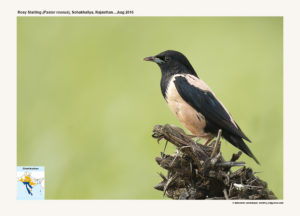
Rosy starling Pastor roseus
Etymology:
- Pastor : Latin word for Shepherd derived from pascere- to lead to pasture
- Roseus : Latin word for Rose coloured derived from rosa – Rose
Vernacular Names:Sind: Wyha, Waheeo, Wyho, Hindi: Gulabimyna, Tilyer, Sans: Shonsaarika, Pun: Gulabitilyar, Bi: Ganggoya, Ben: Lalmyna, Guj: Vaiyo, Gulabivaiya, Kutch: Wyha, Waheeo, Wyho, Mar: Gulabimyna, Bhurdi, Ta: Suraikuruvi, Cholamkuruvi, Te: Pariki pitta, Palisa, Gulabigorinka
Distribution in India: Passage migrant in West, Central and North India. Winter visitor in Gujrat, Western Ghats and South India
Description: Size of 20-21 cm, Wt. of 60–88 g . The male has black head and neck to throat , upper breast is black, glossed purple, upperparts, lower breast and belly pale pastel pink, under tail-coverts blackish; wing blackish-brown, green iridescence on secondaries; tail blackish-brown with green iridescence; iris dark brown; bill pink distally with black base during breeding, dark brown or blackish in autumn, brownish-pink in winter; legs yellowish-horn. In fresh plumage after complete moult (in late summer), male has black feathers tipped buffy grey tips, pink feathers tipped brown, black under tail-coverts dull with brown tips, remiges and wing-coverts with buff margins. Female is similar to male but somewhat duller, with shorter crest; retains buffy feather tips in spring, so that throat, nape and under tail-coverts appear brown. The juvenile is sandy grey-brown above, rump is paler and with pinkish or buff tinge ,ear-coverts are pale, wings and tail are brown with buff feather margins, buff below, chin and throat are paler and with dark feather centers producing spotted appearance, pale eyering. The bill is horn-coloured, base is bright yellowish or orange, legs are pinkish-yellow or straw-coloured. The first-winter bird has dull black head, crown feathers are brown-tipped and not elongated, back and underparts are browner than adult, undertail-coverts are dull black with buff tips.
Habitat: After breeding, it moves to more wooded areas. In non-breeding season it is found in wide variety of habitats, including wooded areas and open country.
Food Habits: It is insectivorous during breeding season, when diet dominated by locusts and other grasshoppers; more fruit taken after breeding, and in winter diet includes insects, fruit, seeds and nectar. Most locusts taken on the ground, birds hurrying in one direction, those at the back of flock flying over those in front so that group moves in a “roller-feeding” manner. Sometimes accompanies cattle. It is highly gregarious at all times; forages in flocks, sometimes large ones.
Breeding Habits: They breed in Feb-May in Southern Parts of India. They are Monogamous. They are found in large colonies often of hundreds and up to several thousands of nests. Nest is built rapidly, by both sexes, from grasses and twigs, lined with finer grasses and feathers, cup may include aromatic plants such as wormwood, giant fennel and the Poaceous grass. The nest is placed in hole, most frequently in interstice between stones on scree slope, in crack in rock or cliff, among stones on railway embankment or quarry, crevice in building, under eaves or in thatch, hole of Collared Sand Martins or hole in tree. They lay a clutch of 3–6 eggs. Incubation is done by both sexes, both may develop brood patch but female much more frequently. Incubation period is for 15 days. The chicks fed by both parents. The nestling period is 24 days. The young fed by both adults for a short period after leaving nest.